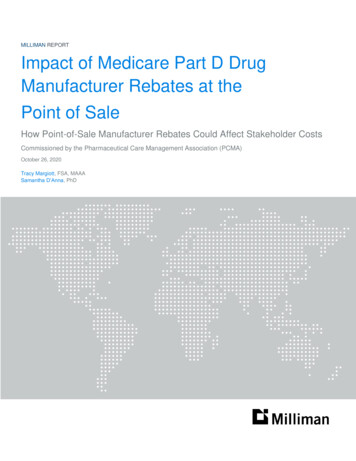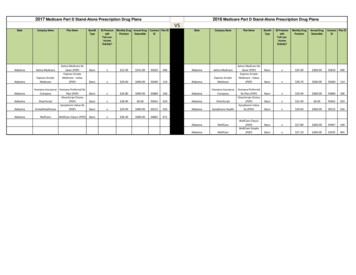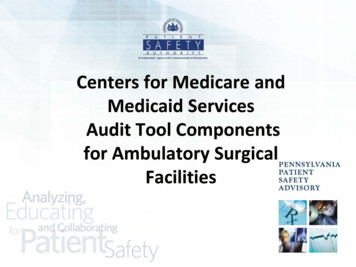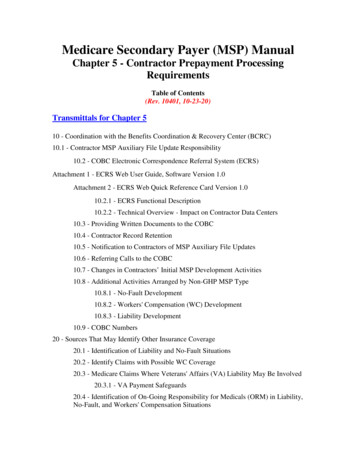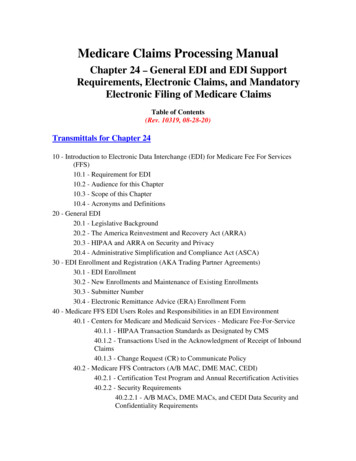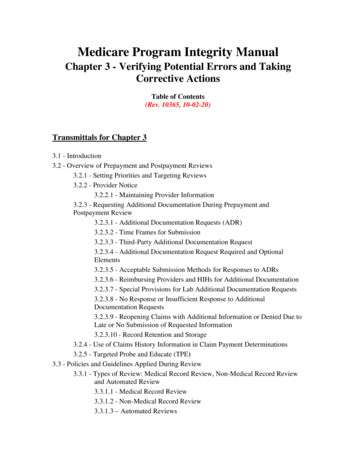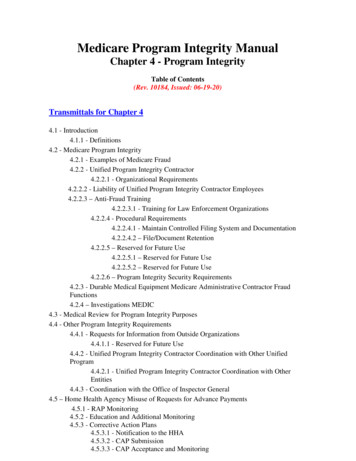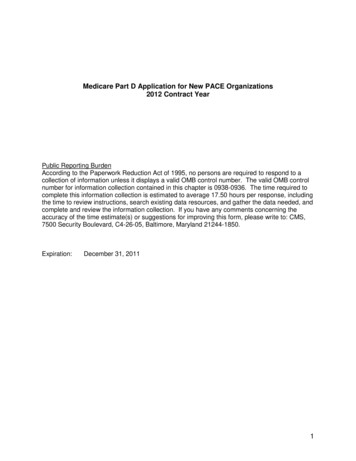
Transcription
Medicare Part D Application for New PACE Organizations2012 Contract YearPublic Reporting BurdenAccording to the Paperwork Reduction Act of 1995, no persons are required to respond to acollection of information unless it displays a valid OMB control number. The valid OMB controlnumber for information collection contained in this chapter is 0938-0936. The time required tocomplete this information collection is estimated to average 17.50 hours per response, includingthe time to review instructions, search existing data resources, and gather the data needed, andcomplete and review the information collection. If you have any comments concerning theaccuracy of the time estimate(s) or suggestions for improving this form, please write to: CMS,7500 Security Boulevard, C4-26-05, Baltimore, Maryland 21244-1850.Expiration:December 31, 20111
I. GENERAL INFORMATION (§423.1- §423.910)BackgroundThe Medicare Prescription Drug Benefit program was established by section 101 of theMedicare Prescription Drug, Improvement, and Modernization Act of 2003 (MMA) and iscodified in section 1860D-1 through 1860 D-42 of the Social Security Act (the Act). Section 101of the MMA amended Title XVIII of the Social Security Act by redesignating Part D as Part Eand inserting a new Part D, which establishes the Voluntary Prescription Drug Benefit Program(hereinafter referred to as “Part D”).The Patient Protection and Affordable Care Act as amended by the Health Care and EducationReconciliation Act of 2010 (HCERA) (together “the Affordable Care Act”) adds section 1860D43 which will close the Medicare Prescription Drug Benefit’s coverage gap by implementing amanufacturer discount program and providing coverage to generic drugs over a span of 10years. The Affordable Care Act also added or revised certain existing Part D requirements,including requirements associated with low-income subsidy, calculation of true out-of-pocketspending, drug classes and categories, LTC pharmacy dispensing techniques, established of asingle uniform exceptions and appeals model, and strengthened CMS’ ability to deny bids.OverviewThe Part D benefit constitutes perhaps the most significant change to the Medicare programsince its inception in 1965 by recognizing the vital role of prescription drugs in our health caredelivery system. However, PACE organizations have a longstanding history of providingstatutorily required prescription drugs to all participants. Prior to Part D, prescription drugs wereincluded as a portion of the Medicaid capitation rate. However, the MMA mandates that StateMedicaid programs may no longer cover Part D drugs on behalf of dual eligible beneficiaries.PACE organizations may elect to offer a Part D plan in a similar manner as MA-PD local plansin order to account for this shift in payer source for prescription drugs.This chapter of the PACE provider application serves as the Medicare Part D application.NOTE: CMS reserves the right to amend or cancel this solicitation at any time. CMS alsoreserves the right to revise the Medicare Prescription Drug Benefit program implementationschedule, including the solicitation and bidding process timelines.2
Summary of PACE Organization’s Roles and ResponsibilitiesEach PACE Organization should have the ability to: Submit a formulary each year for CMS approval (as applicable). Submit a Part D bid each year for CMS approval. Administer the Part D benefit. Provide all required prescription drug services as outlined in the PACE statute andregulation. Operate quality assurance, drug utilization review, and medication therapy managementprograms in accordance with existing PACE requirements. Protect the privacy of beneficiaries and beneficiary-specific health information. Develop and/or maintain systems to support enrollment, provide claims-based data to CMS,accept CMS payment, and support e-prescribing. Provide necessary data to CMS to support payment, oversight, and quality improvementactivities and otherwise cooperate with CMS oversight responsibilities. Ensure the integrity of the Medicare Trust Fund by eliminating fraud, abuse, and wastewithin its organization.Health Plan Management System (HPMS)Completion of the CMS PACE Provider Application and the Part D application (chapter 11) is asignificant step towards attaining CMS approval to provide the Part D benefit to eligible PACEparticipants. In addition, PACE organizations are required to secure access to the CMS HealthPlan Management System (HPMS) in order to carry out additional Part D functions including theformulary submission process (as applicable), the bid submission process, ongoing operationsof the Part D program, and reporting and oversight activities.PACE organizations must obtain HPMS user ID’s and access to the system only after beingassigned a CMS provider number or “H-number”. PACE organizations are assigned CMS "Hnumbers" upon CMS receipt of the PACE provider application. We note that the PACE providerapplication is routed to CMS only after it has been reviewed by the SAA. Once your applicationhas arrived and CMS assigns an “H-number, you will be notified by your CMS PACE team lead.At this point, the PACE organizations staff must obtain HPMS user ID’s in order to access thesystem. The HPMS user ID application may be accessed loads/Access.pdf3
In addition, instructions to PACE organization for completing this form are located uestions concerning HPMS user IDs should be directed to the HPMS Help Desk athelpdesk@hpms@cms.hhs.govSummary Instruction for Part D Formularies (42 CFR §423.120)Applicants that meet one or more of the definitive criteria for formularies described later in thisdocument will be required to upload their plan formularies to HPMS using a pre-defined fileformat and record layout.Summary Instruction for Part D Bids (42 CFR §423.265)Each PACE applicant must submit to CMS, via HPMS, two Part D bids; 1 for dual eligibleenrollees and 1 for Medicare-only enrollees. Applicants using this solicitation must apply tooffer full risk Part D plans.The applicants bid will represent the expected monthly cost to be incurred by the applicant forqualified prescription drug coverage in the plan’s service area for a Part D-eligible beneficiary ona standardized basis. The costs represented in each bid should be those for which theapplicant would be responsible. The bid will require the separate identification, calculation, andreporting of costs assumed to be reimbursed by CMS through reinsurance. CMS requires thatthe bid represent a uniform benefit package among all beneficiaries enrolled in the plan. Thebenefit packages submitted must be cross walked appropriately from the formulary (asapplicable). Pursuant to 42 CFR §423.505(k)(4), the CEO, CFO, or an individual delegated withthe authority to sign on behalf of one of these officers, and who reports directly to such officer,must certify (based on best knowledge, information and belief) that the information in the bidsubmission is accurate, complete, and truthful, and fully conforms to the requirements in section42 CFR §423.265 of the regulations (except section 42 CFR §423.265(b), the applicability ofwhich is discussed below). In addition, the pricing component of the bid must be certified by aqualified actuary.PACE organizations must submit annual Part D bids and receive CMS approval of the Part Dbids prior to providing or continuing to provide Part D benefits. Any PACE organization thatwishes to either continue receiving Part D payment or begin receiving Part D payment inJanuary of a given year, must submit their Part D bids no later than the first Monday in June ofthe year prior. The June bid submission deadline (42 CFR §423.265(b)) has been waived fornewly forming PACE organizations pending the development of a methodology for acceptingmid-year bids.In order to prepare plan bids, Applicants will use HPMS to define their plan structures andassociated plan service areas and then download the Plan Benefit Package (PBP) and BidPricing Tool (BPT) software. For each plan being offered, Applicants will use the PBP softwareto describe the detailed structure of their Part D benefit and the BPT software to define their bidpricing information. The formulary (as applicable) must accurately crosswalk to the PBP.Once the PBP and BPT software has been completed for each plan being offered, Applicantswill upload their bids to HPMS.CMS Review of Part D BidsCMS will evaluate the bids based on four broad areas: 1) administrative costs, 2) aggregatecosts, 3) benefit structure, and 4) plan management. CMS will evaluate the administrative costsfor reasonableness in comparison to other PACE bidders. CMS will also examine aggregate4
costs to determine whether the revenue requirements for qualified prescription drug coverageare reasonable and equitable. In addition, CMS will review the steps the PACE Part D sponsoris taking to control costs, such as through various programs to encourage use of generic drugs.Finally, CMS will examine indicators concerning plan management.CMS is also required to make certain that bids and plan designs meet statutory and regulatoryrequirements. We will conduct an actuarial analysis to determine whether the proposed benefitmeets the standard of providing qualified prescription drug coverage.Overview of Part D Bid NegotiationCMS evaluates the reasonableness of bids submitted by PACE Part D sponsors by means of anactuarial valuation analysis. This requires evaluating assumptions regarding the expecteddistribution of costs, including average utilization and cost by drug coverage tier. CMS couldtest these assumptions for reasonableness through actuarial analysis and comparison toindustry standards and other comparable bids. Bid negotiation could take the form ofnegotiating changes upward or downward in the utilization and cost per script assumptionsunderlying the bid’s actuarial basis. We could exercise our authority to deny a bid if we do notbelieve that the bid and its underlying drug prices reflect market rates.Standard Contract with PACE Part D SponsorsSuccessful Applicants will be deemed qualified to enter into a PACE program agreement thatincludes Part D coverage. Under this agreement the PACE Part D sponsor will be authorized tooperate the Medicare Part D benefit for all eligible PACE participants. Only after the qualifiedApplicant and CMS have reached agreement on the Applicant’s bid submissions will theApplicant be asked to execute its PACE program agreement.General Enrollment ProcessingCMS has developed a system to review an individual’s eligibility for the Part D benefit. Forindividuals applying for enrollment in a Part D plan, CMS reviews an individual’s status as aMedicare beneficiary. CMS tracks enrollments and ensures that the beneficiary does not enrollin more than one plan. Also, CMS tracks low-income subsidy status and auto-enrollments offull-benefit dual eligible individuals into Part D plans and facilitated enrollments for other lowincome Medicare beneficiaries. Finally, CMS tracks disenrollments from Part D plans and willdeny new enrollments during any given year unless the enrollment occurs during an allowableenrollment period. For additional information regarding enrollment processing, refer to thehttp://www.cms.gov website.Eligibility for the Low Income Subsidy ProgramLow-income Medicare beneficiaries receive full or partial subsidies of premiums and reductionsin cost sharing under the Part D benefit. Certain groups of Medicare beneficiaries areautomatically be eligible for the low-income subsidy program. These beneficiaries includeMedicare beneficiaries who are full-benefit dual eligible individuals (eligible for full benefitsunder Medicaid), Medicare beneficiaries who are recipients of Supplemental Security Incomebenefits; and participants in Medicare Savings Programs as Qualified Medicare Beneficiaries(QMBs), Specified Low-Income Medicare Beneficiaries (SLMBs), and Qualifying Individuals(QIs). Beneficiaries who are low-income and who do not fall into one of the automatic subsidyeligibility groups apply for a low-income subsidy and have their eligibility determined by eitherthe state in which they reside or the Social Security Administration (SSA). CMS has developeda database to track individuals who are automatically deemed subsidy-eligible or who aredetermined subsidy-eligible by states or SSA, and communicates the names and eligibilitycategory of those individuals to Part D sponsors as part of the enrollment files from the5
enrollment processing system described below. For additional information regarding the lowincome subsidy program, refer to the www.cms.gov/ website.Protection of Confidential InformationApplicants may seek to protect their information from disclosure under the Freedom ofInformation Act (FOIA) by claiming that FOIA Exemption 4 applies. The Applicant is required tolabel the information in question “confidential” or “proprietary”, and explain the applicability ofthe FOIA exemption it is claiming. This designation must be in writing. When there is a requestfor information that is designated by the Applicant as confidential or that could reasonably beconsidered exempt under Exemption 4, CMS is required by its FOIA regulation at 45 C.F.R.§5.65(d) and by Executive Order 12,600 to give the submitter notice before the information isdisclosed. To decide whether the Applicant’s information is protected by Exemption 4, CMSmust determine whether the Applicant has shown that— (1) disclosure of the information mightto impair the government's ability to obtain necessary information in the future; (2) disclosure ofthe information would cause substantial harm to the competitive position of the submitter; (3)disclosure would impair other government interests, such as program effectiveness andcompliance; or (4) disclosure would impair other private interests, such as an interest incontrolling availability of intrinsically valuable records, which are sold in the market. Consistentwith our approach under the Medicare Advantage program, we would not release informationunder the Medicare Part D program that would be considered proprietary in nature.Payment to PACE Part D SponsorsPayments will be wired to the organization’s account on the first day of each month (or the lastbusiness day of the prior month if the first day of the month is not a business day). The monthlypayment will include premiums that SSA or other agencies are deducting from beneficiarySocial Security payments or other payments as well as those premiums CMS is paying onbehalf of low-income individuals. Estimated monthly reinsurance subsidies, low-incomesubsidies, and gap discount amounts are also included.Applicability of the National Provider Identifier (NPI) to PACE OrganizationsThe Administrative Simplification provisions of the Health Insurance Portability andAccountability Act of 1996 (HIPAA) mandated the adoption of standard unique identifiers forhealth care providers, as well as the adoption of standard unique identifiers for health plans.The purpose of these provisions is to improve the efficiency and effectiveness of the electronictransmission of health information. The NPI has been adopted as the standard unique identifierfor health care providers. The National Plan and Provider Enumeration System (NPPES) is theentity that assigns these unique identifiers.For purposes of HIPAA, PACE organizations may be defined as both health plans and healthcare providers. We note that an enumeration system applicable to health plans is still in thedevelopment stages. However, any health care provider, as that term is defined for purposes ofHIPAA that transmits any health information in electronic form in connection with one of thestandard transactions, including electronically billing any health plan (including Medicare), mustobtain an NPI. Health care providers are defined at 45 CFR §160.103 as “a provider of services(as defined in section 1861 (u) of the Act, 42 USC 1395x (u)), a provider of medical or healthservices (as defined in section 1861(s) of the Act, 42 ISC 1395x(s)), and any other person ororganization who furnishes, bills, or is paid for health care in the normal course of business.”Although PACE organizations may meet the definition or a health care provider, as describedabove, only those that transmit health information in electronic form in connection with one ofthe standard transactions, including billing any health plan electronically must obtain an NPI.6
We note that in some instances, PACE organizations may elect to provide Medicare services toa beneficiary prior to the beneficiary’s effective date of PACE enrollment. These services maybe billable under Medicare Fee-For-Service. To the extent a PACE organization that is a HIPAAhealth care provider elects to bill Medicare electronically for these non-PACE services, an NPIwould be needed.In addition, consistent with HIPAA requirements, as health plans, all PACE organizations(regardless of whether the NPI requirements apply to them as health care providers) arerequired to accept and recognize the NPI as the health care provider identifier in standardtransactions that are submitted to them from health care providers or other health plans.7
II. GENERAL INSTRUCTIONSSummary Instructions and Technical SupportThis application is to be completed by those newly forming PACE organizations that intend toprovide the Part D benefit to eligible participants beginning in 2012. Applicants projecting PACEprovider status by 1/1/2012 may submit the Part D application (chapter 11 of the PACE providerapplication) up until July 1, 2011. Applicants must use the 2012 solicitation. CMS will not acceptor review in any way those submissions using prior version of the application.For technical assistance in the completion of this application, contact:Jack Healey by email at: jackie.healey@cms.hhs.gov or by phone at 410-786-3683.InstructionsApplicants must include the name of the PACE organization in the heading on each page of thePart D application submitted to CMS.In many instances Applicants are directed to affirm that they will meet particular requirements byindicating “Yes” next to a statement of a particular Part D program requirement. By providingsuch attestation, an Applicant is committing its organization to complying with the relevantrequirements as of the date your contract is signed, unless an alternative date is noted.Additional supporting documentation is notated in the following manner throughout theapplication and is to be submitted as follows:Forms: documents supplied by CMS that are contained at the end of this application. They areto be completed by the Applicant and returned to CMS as indicated.Legal documents such as subcontracts should be provided in hard copy as an attachment to theapplication. In addition, all subcontracts and other legal documents should be provided on theCD or diskette copies of the application. The CD/diskette identification should include the formnumber.CMS will check the Part D application for completeness shortly after its receipt. We will notifyApplicants of any deficiencies and afford them the opportunity to amend their Part Dapplications.CMS may verify a sponsor’s compliance with qualifications it attests it will meet, through on-sitefacility visits as well as through other program monitoring techniques.Failure to meet the requirements attested to in the Applicant’s response to this solicitation andfailure to operate its Part D plan(s) consistent with the requirements of the applicable statutes,regulations, and the Part D contract may disqualify it from participation in the Part D program.An individual with legal authority to bind the Applicant shall sign and submit the certification.CMS reserves the right to request clarifications or corrections to a submitted application.Failure to provide req
Medicare Part D Application for New PACE Organizations . 2012 Contract Year . Public Reporting Burden According to the Paperwork Reduction Act of 1995, no persons are required to respond to a . Questions concerning HPMS user IDs should be directed to the HPMS Help Desk

